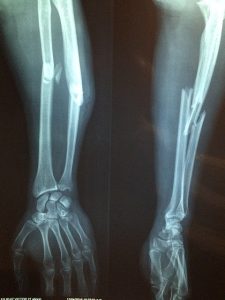Where Did This Stuff Come From? Life Transitions & Extra Stuff
Your parents downsize and want you to take some of their stuff. You’re expecting your first child and everyone gives you gifts. You suffer a severe break to your leg and require medical equipment.
 Each of these situations represents a transition that increases the number of items in your space. The features of the passage impact the amount of stuff-overwhelm you may experience.
Each of these situations represents a transition that increases the number of items in your space. The features of the passage impact the amount of stuff-overwhelm you may experience.
In “I Used to Be Organized:” How Life Transitions Impact Your Organization and Productivity, I differentiated transitions from changes. I also outlined the Transition Cycle.
In this article, I’ll show you how recognizing the characteristics of life transitions helps you manage extra stuff that enters your space during this time.
The first level of life transitions includes:
- Welcome vs. unwelcome: is it perceived as positive or negative?
- Temporary vs. permanent: a car accident may result in a broken leg that takes several months to heal or it may cause a permanent brain injury.
- Broad categories: a different status in an area of life (see below for further explanation).
- Expected vs. unexpected:
- self-imposed or imposed on us, such as deciding to leave one job for another vs. being laid off.
- events vs. non-events, such as expecting to get married someday and never finding the right person.
- Instantaneous vs. gradual: brain injury from a car accident vs. age-related dementia.
The broad categories include:
- Life stage: a specific phase of development in your life cycle, for instance beginning or ending of a serious relationship, the death of a friend or loved one, retirement, starting at a new school, or caring for aging parents.
- Work life (see below for further explanation).
- Personal: changes in your personal life such as moving and relocation or dealing with major upheaval subsequent to a destructive weather-related emergency.
 Medical: a new medical diagnosis or serious illness.
Medical: a new medical diagnosis or serious illness.
- Mental: a new psychological or mental health diagnosis.
Work life transitions can be further broken down:
- New job: same basic skills and responsibilities with a different company.
- New career: occupation change.
- New responsibilities: different job within the same company.
Using this framework for understanding life transitions, let’s explore a couple of examples.
EXAMPLE #1 Blended Family
Since a blended family, by definition, includes combining households with one or more children from a previous relationship, then by its very nature, there will be an increased amount of stuff in the home.
Using the framework above, the blending of families is a personal, life stage shift. Commonly it also involves a move and change of job or school. Each person will have a different take on it: positive or negative, excited or upset, etc.
When it comes to the stuff, there are often duplicates of kitchen, cleaning, toiletry, linen, etc. supplies, not to mention furniture. And if wedding gifts are received, there may be triplicates of some items.
If the parties live relatively close to each other, are moving to a “neutral” location and have the time, they may be able to declutter each home as they move into the new one. If they live farther apart or if the timing is off, then everyone’s possessions may end up at the new home at the same time.
Intentionally designing the life transition into a blended family greatly reduces stuff-overwhelm!
EXAMPLE #2 Medical
An accident results in a major injury to the dominant arm/hand.  It may be a child who tumbled out of a tree. It might be an adult who tripped and fell.
It may be a child who tumbled out of a tree. It might be an adult who tripped and fell.
Regardless, it is an unexpected, instantaneous, medical life transition. It’s probably unwelcome…unless it gets the person out of a task they desperately want to avoid.
Even if surgery is necessary, it is probably a temporary condition. Although I know of someone who lost fine motor control from such a break and will never regain her previous level of functioning.
There are numerous ways such a scenario may impact the amount of stuff in a space: medications increase and physical therapy equipment requires space. Items previously in drawers, cabinets, and closets need to stay out to be accessible. If the person mainly wears shirts that go over their head, they may have to purchase ones that button.
In a temporary situation, these items can be deleted (donated, recycled, etc.) when the arm is totally healed. If you decide to keep the items “just in case,” then you’ll need to contain them.
Since the broken arm wasn’t planned for, you’re acquiring all of these items due to the emergency which leaves little time to incorporate them into your overall organization.
Again, a life transition has increased your stuff. How will you handle it?
You may not have experienced either of these examples, however, I’m certain you’ve been through some life transitions. And I’m positive there are more passages in your future. Hopefully, the information in this article will help you decrease the stuff-overwhelm commonly associated with life transitions.
When you’re undergoing a life transition, stuff-overwhelm isn’t fun! Life Transitions Organizing has worked with hundreds of clients, to reach their decluttering and organizing goals. Reach out today at 919-467-7058 or via our website.
Tag:ADHD, anxiety, autoimmune disease, brain based disorders, depression, expected, family, items, life transitions, Life Transitions Organizing, Life Transitions Resources, life-disrupting situation, medical, permanent, productivity and organizing professional, professional organizer, stuff, stuff management, TBI, temporary, things, Transition Success Program, unexpected, work


